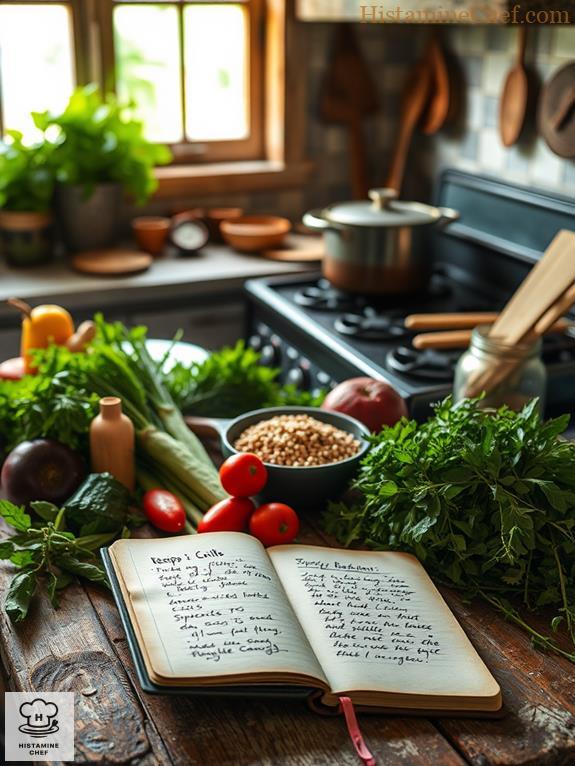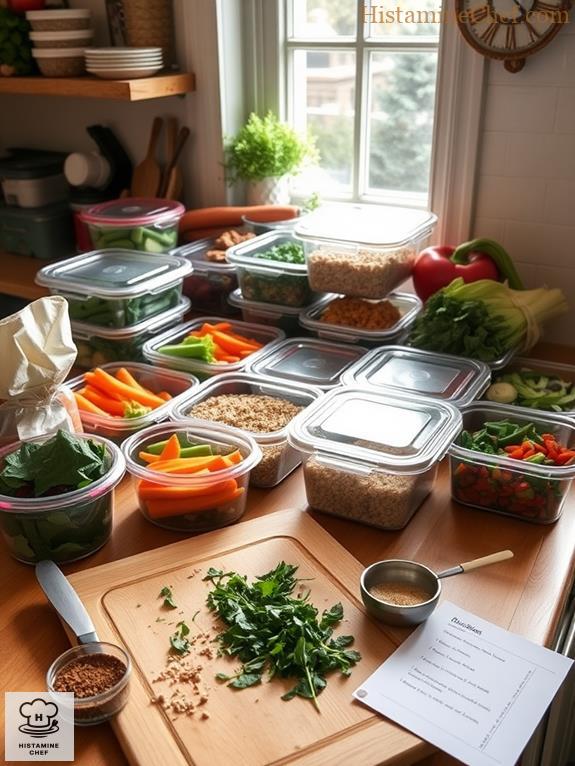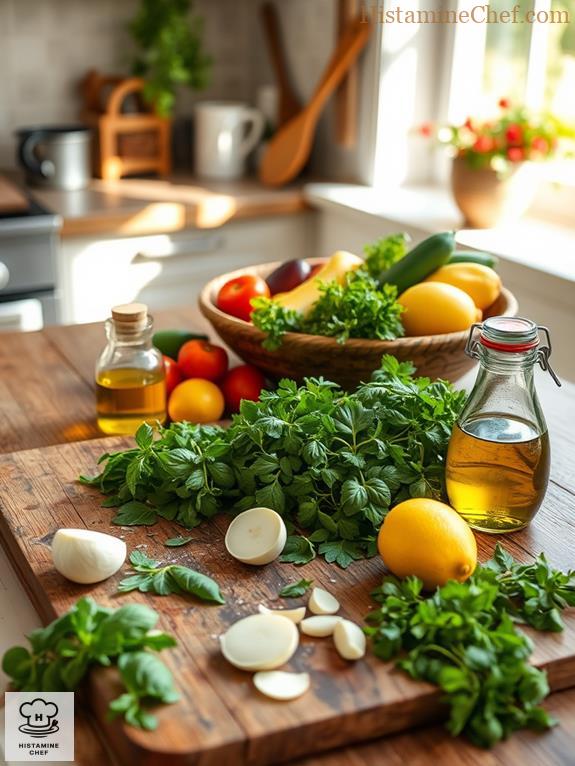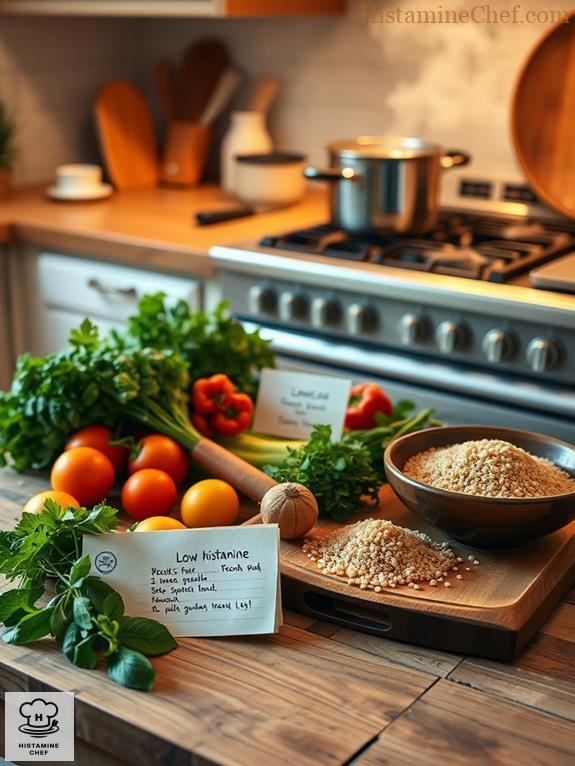Tired of histamine-induced food drama? I’ve got your back!
I remember when histamine intolerance turned my kitchen into a culinary minefield. Talk about a plot twist! But fear not, I’ve cracked the code.
Steaming and baking are your new BFFs. They’re like the superheroes of histamine-friendly cooking, keeping those pesky levels in check.
Fresh ingredients are key. Think chicken straight from the butcher, not last week’s leftovers. And herbs? They’re your flavor saviors.
Meal prep isn’t just trendy, it’s a lifesaver. Trust me, your future self will thank you.
Ready to dive in? Let’s make histamine-friendly meals that’ll have your taste buds doing a happy dance!
My Histamine Rollercoaster: From Kitchen Nightmares to Culinary Bliss
When histamine intolerance hit me, my beloved spicy curries became the enemy. Suddenly, I was that person at restaurants, asking a million questions about ingredients. Talk about awkward!
But it pushed me to experiment. I discovered the joy of fresh herb pestos and learned that slow-cooking isn’t just for grandmas.
Now, my kitchen’s a low-histamine haven, and I’ve even converted some friends. Who knew avoiding leftovers could be so trendy?
Understanding Histamine Sensitivity

Understanding histamine sensitivity can be a game-changer for those of us who experience adverse reactions to certain foods.
Histamine intolerance, also known as histaminosis, can manifest in various symptoms and is often linked to diet.
Learning about histamine-related disorders can help in managing symptoms effectively.
I recall the first time I felt the effects of histamine reactions—it was like a rollercoaster ride without the fun!
Making dietary adjustments became my secret weapon.
The SIGHI list became my best friend, guiding me toward delicious, low-histamine foods like apples and quinoa, while steering clear of sneaky culprits like tomatoes and aged cheese.
By understanding histamine sensitivity, I gained control over my meals and, ultimately, my life.
When you embrace these changes, you empower yourself to enjoy food again!
Safe Cooking Methods

When it comes to cooking safely with histamine sensitivity, I’ve discovered some foolproof methods that really work!
Steaming techniques are particularly effective for low-histamine cooking, preserving nutrients while minimizing histamine formation.
Steaming vegetables keeps them vibrant and delicious, while grilling fresh proteins adds that mouthwatering char without raising histamine levels.
Plus, baking with safe ingredients can turn your kitchen into a haven for tasty treats—who wouldn’t want that?
Steaming Vegetables Effectively
Steaming vegetables is one of the best ways to preserve their nutrients while keeping them histamine-friendly.
When I steam, I keep the vibrant colors and crunch that make veggies so enjoyable.
Plus, the steaming benefits are incredible! It’s simple: just bring water to a boil, place your chosen veggies—like carrots or zucchini—into a steaming basket, and cover.
In about 5-7 minutes, you’ll have perfectly cooked greens that retain their flavor and nutrients.
Let’s be honest, who doesn’t love a bright, tasty plate of steamed veggies?
And with the SIGHI list as our guide, we can skip the restricted ones like spinach or tomatoes.
Join me on this journey with Histamine Chef, where cooking deliciously is a powerful tool!
Grilling Fresh Proteins
After enjoying a colorful plate of steamed vegetables, it’s time to think about how to grill fresh proteins in a way that’s both delicious and histamine-friendly.
Grilling techniques can elevate your meals! I love marinating fresh chicken or fish in a mix of olive oil and fresh herbs. It’s a game changer!
Just bear in mind to avoid any high-histamine ingredients like soy sauce or vinegar.
Once marinated, grill them on medium heat until they’re perfectly cooked. The sizzle is music to my ears, right?
And let’s not forget, fresh proteins like turkey or beef can also shine on the grill.
Baking With Safe Ingredients
Baking with safe ingredients opens up a world of delicious possibilities for those managing histamine sensitivities.
I’ve discovered that using the right baking substitutes and understanding ingredient ratios can transform my kitchen adventures!
Here are three safe ingredients to contemplate:
- Quinoa flour for a nutty flavor
- Coconut sugar as a low-histamine sweetener
- Oat milk for a creamy texture
With these swaps, I can whip up treats without the worry!
Remember, it’s all about experimentation.
Adjusting ingredient ratios can lead to surprisingly delightful results!
Ever tried a quinoa flour cookie? Trust me, they’re a hit!
Ingredient Selection Tips

When it comes to ingredient selection, I always start by choosing allowed foods from the SIGHI list, because who wants to deal with pesky histamine?
You’ll find that fresh fruits like apples and blueberries aren’t only tasty but also safe bets.
Reading food labels is essential for identifying hidden histamines in packaged foods. Familiarize yourself with common histamine-triggering ingredients to make informed choices.
Choosing Allowed Ingredients
Steering through the world of histamine-friendly cooking can feel overwhelming, but choosing allowed ingredients is key to enjoying delicious meals without discomfort.
Let’s explore some powerful choices!
- Allowed fruits like apples and blueberries are a must.
- Allowed vegetables including carrots and zucchini can brighten your plate.
- Don’t forget about allowed proteins like fresh chicken and fish for that satisfying crunch.
Identifying Restricted Foods
Understanding which foods to avoid is just as important as selecting allowed ingredients.
When I first started my journey, recognizing high histamine foods felt like hunting for treasure—only to discover landmines! For instance, restricted food examples include pickled vegetables, aged cheese, and processed meats. These sneaky culprits can wreak havoc on your body.
Make a habit of checking the SIGHI list as your trusty map. It’s your secret weapon against accidental histamine overload!
So, keep your eye out for those troublemakers in your pantry. Recall, the goal is to empower yourself in the kitchen. Who knew avoiding certain foods could feel like a superhero power?
Join me, and let’s conquer those restricted foods together!
Meal Prep and Storage

Meal prep and storage can make a significant difference in managing a histamine-friendly diet.
I’ve found that planning ahead empowers me to stay on track and avoid those sneaky high-histamine foods.
Smart storage techniques are essential for maintaining the freshness and safety of histamine-friendly foods. Proper storage can help minimize histamine formation in prepared meals.
Here are a few tips I swear by:
- Create a Meal Prep Schedule: Dedicate a specific day to chop, cook, and store your meals.
- Utilize Airtight Containers: Keep your prepared dishes fresh and free from contamination.
- Label Everything: You’d be surprised how a little label can save you from a histamine disaster!
Flavoring Without High Histamine

I often find that flavoring my meals without high-histamine ingredients can be a creative challenge.
But it’s also a chance to get inventive!
Instead of reaching for conventional spices like cumin or mustard, I turn to herb alternatives like fresh basil, oregano, or thyme. They pack a punch without the histamine hangover!
For those looking to expand their histamine-friendly herb options, consider adding rosemary or sage to your culinary arsenal.
When I need a kick, I use spice substitutes like turmeric or ginger. They not only add zest but also boast health benefits.
Have you ever tried a sprinkle of cinnamon on your sweet potato? Trust me, it’s a game-changer!
Cooking Techniques to Avoid

When cooking with histamine sensitivity in mind, it’s essential to avoid certain techniques that can inadvertently elevate histamine levels in your meals.
Smart cooking techniques can help reduce histamine content in your food, making meals more enjoyable for those with sensitivities. Adapting recipes often involves modifying cooking methods to maintain flavor while minimizing histamine formation.
Here are three cooking methods to steer clear of:
- High-Temperature Cooking: Frying or grilling can create high histamine foods that’ll leave your tummy grumbling.
- Long Cooking Times: Slow-cooking can allow histamine to build up, especially with certain ingredients.
- Fermentation: Avoid anything fermented, as it’s a histamine party that you definitely don’t want to crash!
Sample Low Histamine Recipes

Creating delicious low histamine meals can be both simple and satisfying, especially with the right recipes at hand.
I love whipping up easy recipes that not only taste great but also respect my body’s needs. For example, try a quinoa salad loaded with fresh blueberries, pears, and a drizzle of olive oil—simple, right?
If you don’t have quinoa, rice works well, too! When adapting recipes, consider smart substitutions for common ingredients to keep your meals low in histamine.
Feeling adventurous? Mix sweet potatoes with coconut milk and a pinch of cinnamon for a creamy delight.
Remember, ingredient substitutions can make a huge difference!
I write this blog, Histamine Chef, to help you conquer histamine issues without sacrificing flavor.
FAQ
Can I Use Frozen Ingredients for Low Histamine Cooking?
Absolutely, I love using frozen vegetables for meal prepping! They’re convenient, maintain nutrients, and help me stick to low histamine options. It’s a powerful way to guarantee I have delicious meals ready anytime.
How Can I Identify High Histamine Foods at the Grocery Store?
When I shop, I focus on identifying histamine-rich foods by checking labels and avoiding aged products. For instance, I skip aged cheeses. These shopping tips for histamine sensitive folks empower me to make safer choices.
Are There Specific Brands That Cater to Histamine-Sensitive Diets?
I’ve found that some brands cater to histamine-sensitive diets. I always check product labels for ingredients and certifications. Brands like So Delicious and Simple Mills often offer options that work well for my needs.
What Kitchen Tools Are Best for Histamine-Friendly Cooking?
When I cook histamine-friendly meals, I rely on quality kitchen storage for fresh ingredients and versatile cooking methods like steaming or slow-cooking. These tools empower me to create delicious, safe dishes without compromising my health.
How Do I Handle Histamine Sensitivity in Social Dining Situations?
Did you know nearly 15% of people experience histamine sensitivity? When dining socially, I prioritize dining etiquette by suggesting food substitutions, ensuring my meal aligns with my needs while maintaining a confident, enjoyable atmosphere for everyone.
Summary
I’ve discovered cooking with histamine sensitivity can be delicious and fun. By choosing fresh ingredients and exploring new techniques, I create safe, flavorful meals. With practice, I’ve become adept at histamine-friendly cooking, turning it into an enjoyable adventure in the kitchen.
Have you experimented with histamine-friendly cooking? Share your experiences and favorite recipes in the comments below.
Help spread awareness about histamine-friendly cooking by sharing this post on your social media. Your support helps grow the Histamine Chef blog and reaches others who may benefit from this information.


Leave a Reply